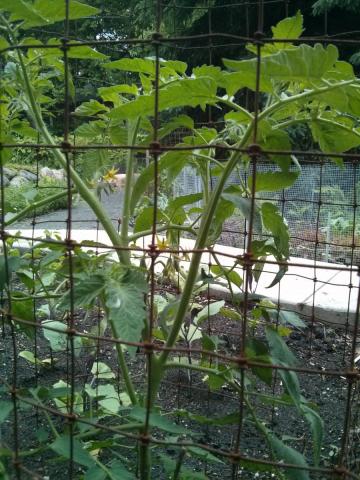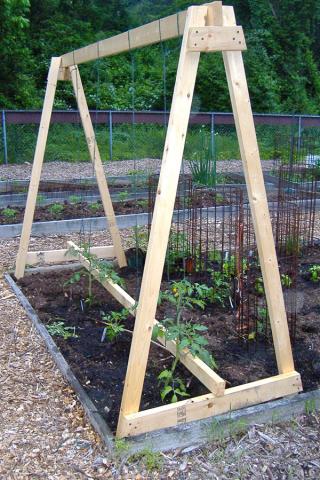

by Laura Bradley, master gardener
With the beautiful weather of the last two weekends, we hope everyone has gotten a chance to plant their main-season garden. Zucchini are growing so quickly I can almost hear it, and I have already gotten some strawberries and snap peas, but the star of the garden—the tomato—is still in her early stages. Of all the vegetables grown in the Midwest, only one is so popular it has its own weekend at the Chicago Botanic Garden (August 23-24). Garden fresh tomatoes are the reason many people start growing. Now that yours are in the ground, let’s do our best to keep them healthy.
Trellising:
Tomatoes, like teenagers, need a lot of support. Left on their own they would fall flat on their face. By keeping the tomatoes off the ground, we reduce the incidences of disease and increase airflow and light to the plant. There are many options for support such as tying them up or caging them (tomatoes, not teenagers!). If you tie them to a stake be sure it is at least five feet tall to accommodate the plant through maturity. Advanced gardeners sometimes trellis their tomatoes by building a frame to suspend a horizontal bar above their plants and tying their tomatoes' main stems to the bar. If you would like to give this a try, gently wrap the stem at least three times, and be careful not to tie it too tightly as this might damage the plant. Tie the other end to the cross bar. As the plant grows taller, simply untie the string from the bar, tighten it, and reattach to the bar. Whatever system you prefer, it is best to get it in place while the plant is small, or even prior to planting to avoid damaging the root structure.
Pruning:
Tomato plants are prone to producing suckers, the branches that grow out of the crotch joint of two branches. Suckers will compete with the main stem of your plant, and eventually grow their own branches, flowers, and fruit. While it is not required that you remove them, if you are growing an indeterminate tomato plant, you can keep the plant from getting too unwieldy and heavy by removing these branches to increase the size of each tomato. (You may get fewer tomatoes, but they will be larger and may be earlier.) To remove the suckers, simply pinch them out with your thumb and forefinger and by removing them while they are small, you are less likely to damage the rest of your plant. If your tomato is a determinate variety, pruning is generally not necessary.
Watering:
Tomatoes need deep, consistent watering. If you miss a week and try to make up for it, you risk cracking the fruit. Generally, vegetables need 1 inch per week. To know if you have gotten to an inch of rain this week or not, place an empty tuna can near the plant. If the can is full, you got an inch, if not, you need to water some more. To minimize diseases and fungus, try not to let the water splash up on the plant while watering. Drip irrigation or self-watering containers are best.
Feeding:
Blossom end rot is one of the most common problems with tomato fruit development. This disease is actually caused by a calcium deficiency, so if you see the ends of your fruit turning black, work calcium into the soil. There are products you can buy at the store, but some people use finely ground egg shells instead.
Pests:
Tomato hornworms eat the leaves of our tomatoes, eggplants, peppers, and potatoes. Luckily, the caterpillars get up to 3 or 4 inches long, so if you can find them you can just pull them off. Unfortunately, they are the same green as your tomato plant! Monitor for leaf damage. If your plant looks nibbled on, your best bet for finding the culprit is going to be along the stem or on the underside of one of the leaves.
